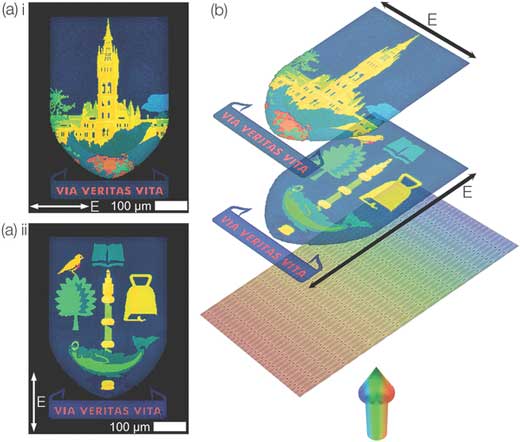| Posted: Sep 20, 2017 |
Nanoscale 'printing' allows display of two colors per pixel
(Nanowerk News) New research from the University of Glasgow, published in Advanced Functional Materials ("Plasmonic color filters as dual-state nano-pixels for high density micro-image encoding"), outlines how engineers have developed nano-scale plasmonic colour filters that display different colours depending on the orientation of the light which hits it.
|
|
Essentially, this new technique allows the ‘printing’ of two entirely different, but exceptionally detailed, full-colour images within the same surface area – something which has never been done before using ‘structural colour’ techniques.
|
 |
| Bright-field microscope images showing the switchable nature of the information displayed by a single set of nanopixels. a) Bright-field transmission images showing the full-color pictures produced by the array when illuminated from the rear with white light at different polarizations. Switching the polarization of light causes the image displayed in the far-field to switch. b) Schematic showing how the images were taken. A white-light source passes through a linear polarizer before being selectively transmitted through the nanoapertures (pixels). At each polarization state the aperture transmits color corresponding to the desired display pattern.
|
|
Instead of relying on dyes and pigments, as in traditional printing, structural colour uses specially structured nanomaterials to render colours. The nanomaterials allow for much higher-resolution prints which do not fade over time. A typical printed image in a magazine, for example, might consist of around 300 coloured dots per inch of page, or 300 DPI. A page ‘printed’ with structural colour techniques, however, could reach a resolution of 100,000 DPI or more.
|
|
The University of Glasgow team’s breakthrough comes from including an additional nanoscale element in the structural colour process, created at the University’s James Watt Nanofabrication Centre.
|
|
Biomedical engineering lecturer Dr Alasdair Clark is the lead author of the research paper. Dr Clark said: “We’ve discovered that if we make colour pixels from tiny cross-shaped indents on a strip of aluminium film, the colour they display becomes polarisation-dependent, allowing us to encode two colours into a single pixel, and then select which colour is displayed by shining different polarisations of light at the surface.
|
|
“By changing the size and shape of the nanoscale indent, we can create a wide range of different colours at very high resolutions.”
|
|
The team, from the University’s School of Engineering, have demonstrated their technique with several examples, including a nanoscale image which shows the University’s crest when the light reaches it in one orientation, and an image of the famous University tower when the orientation of the light is reversed.
|
 |
| Bright-field and SEM images of a switchable QR-code. a-i,ii) Bright-field images of a 16 µm QR code (20 µm with border included) taken using a 100× objective lens when the illuminating white light is polarized along the x and y axes of the code, respectively. A different QR code is visible at each polarization state. To view the information stored within the dual-state QR code, a QR reader capable of scanning reversed contrast codes, such as I-nigma, is necessary (bright patterns on dark backgrounds). b) A wide-area SEM image showing the pattern present in the top-right corner of the QR code. SEM was taken before the deposition of the SiO2 layer.
|
|
Dr Clark added: “There are a lot of potential applications for our plasmonic colour technology, which we’re really excited about.
|
|
“It’s ideal for long-term data archival due to its ultra-high resolution, and because the colours won’t fade even when exposed long-term to the harshest sunlight. We’ve worked out that we could store 1.46 Gb per square centimetre, so a single A4 sheet could hold more than 900 Gb of data.
|
|
“Secondly, the process to produce the plasmonic colours is difficult to replicate without access to dedicated facilities, so it could be ideal for creating a new kind of anti-counterfeiting material for banknotes.
|
|
“Lastly, it offers the possibility of developing new types of colour filters for digital photography.”
|


